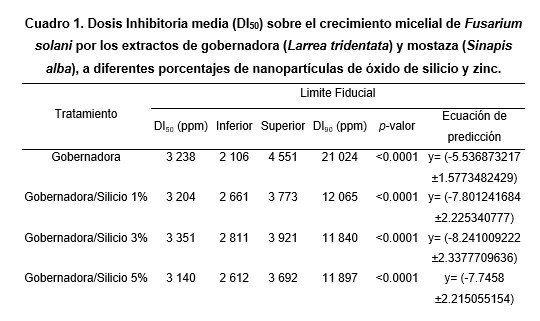In vitro antifungal activity of nanoformulations for the control of Fusarium solani
DOI:
https://doi.org/10.29312/remexca.v15i2.3076Keywords:
nanoparticles, mycelial growth, sporulationAbstract
The objective of the research was to evaluate the in vitro antifungal activity of two extracts, creosote bush (Larrea tridentata L.) and mustard (Sinapis alba L.), nanoformulated with silicon oxide and zinc oxide nanoparticles (200 to 400 μ globular) on the mycelial growth and sporulation of Fusarium solani, one of the plant pathogens causing vascular wilt and root rot in at least 100 economically important crops. Inhibitory concentrations and the number of conidia were determined using the poisoned media method. Data were analyzed using probit analysis, Anova, and Tukey’s test (p≤ 0.05). The results showed that mustard-only treatments have the most effective ID50 with 920.57 ppm; nevertheless, the mixture of mustard and creosote bush with SO2 presented significant results on sporulation, with a formation of 0.35 and 0.48 million conidia ml-1 for creosote bush 3% SO2 and mustard 5% SO2 compared to the control (7.78).
Downloads
References
Bustillo, A. E. 2010. Método para cuantificar suspensiones de esporas de hongos y otros organismos. Universidad Nacional de Colombia, Palmira, Colombia. Doi:10.13140/RG.2.1.3594.5128.
Cedillo-Portugal, E. y Anaya-Rosales S. 2018. Implicaciones socioeconómicas por la implementación de programas de sanidad, calidad e inocuidad alimentaria en el sector productivo de frutas y hortalizas en México. Agro Productividad. 11(2):140-146.
Drakopoulos, D.; Meca, G.; Torrijos, R.; Marty, A.; Kägi, A.; Jenny, E. y Vogelgsang, S. 2020. Control of Fusarium graminearum in wheat with mustard-based botanicals: from in vitro to in plant. Frontiers in. 11: 1 -15. Doi.org/10.3389/fmicb.2020.01595.
El-Mohamedy, R. S.; Abdel-Kareem, F. y Daami-Remadi, M. 2014. Quitosano y Trichoderma harzianum como alternativas fungicidas para el control de la pudrición de la corona y la raíz por Fusarium del tomate. Gestión. 3(4):5-6.
Ezziyyani, M.; Sánchez, C. P.; Requena, M. E.; Rubio, L. y Castillo, M. E. C. 2004 Biocontrol por Streptomyces rochei-Ziyani-, de la podredumbre del pimiento (Capsicum annuum L.) causada por Phytophthora capsici. In Anales de Biología. Servicio de Publicaciones de la Universidad de Murcia. 26:61-68.
Huang, C. H.; Roberts, P. D y Datnoff, L. E. 2011. El silicio suprime la pudrición de la corona y la raíz por Fusarium del tomate. Revista de Fitopatología. 159(7‐8):546-554.
Labiadh, H.; Lahbib, K.; Hidouri, S.; Touil, S. and Chaabane, T. B. 2016. Insight of ZnS nanoparticles contribution in different biological uses. Asian Pacific Journal of Tropical Medicine. 9(8):757-762.
Leslie, J. F. y Summerell, B. A. 2006. Talleres de laboratorio de Fusarium: una historia reciente. Investigación sobre Micotoxinas. 22(2):73-74.
Lira-Saldivar, R. H.; Méndez-Argüello, B.; Santos-Villarreal, G. D. L. y Vera-Reyes, I. 2018. Potencial de la nanotecnología en la agricultura. Acta Universitaria. 28(2):9-24.
SENASICA. 2020. Servicio Nacional de Sanidad, Inocuidad y Calidad Agroalimentaria. Exportación de productos agrícolas. Las actividades se fundamentan en la Ley federal de sanidad vegetal. https://www.gob.mx/senasica/acciones-y-programas/ exportacion-de-productos-agricolas-149565.
Siddiqui, Z. A.; Parveen, A.; Ahmad, L. and Hashem, A. 2019. Effects of graphene oxide and zinc oxide nanoparticles on growth, chlorophyll, carotenoids, proline contents and diseases of carrot. Scientia Horticulturae. 249:374-382.
Singh, J. K.; Kumar, M.; Kumar, S.; Kumar, A. y Mehta, N. 2017. . Inhibitory effect of botanicals on growth and sporulation of Fusarium oxysporum inciting wilt of chilli (Capsicum annuum L.). Journal of Pharmacognosy and Phytochemistry. 6(5):2199-2204.
Šišić, A.; Baćanović-Šišić, J. y Al-Hatmi, A. M. S., Karlovsky, P.; Ahmed, S. A.; Maier, W.; de Hoog, G. S. and Finckh M. R. 2018. El número ‘forma specialis’ en Fusarium: un estudio de caso en Fusarium solani f. sp. Pisi. Informes científicos. 8(1):1-17. https://doi.org/10.1038/s41598-018-19779-z.
Tequida-Meneses, M.; Cortez-Rocha, M.; Rosas-Burgos, E. C.; López-Sandoval, S. y Corrales-Maldonado, C. 2002. Efecto de extractos alcohólicos de plantas silvestres sobre la inhibición de crecimiento de Aspergillus flavus, Aspergillus niger, Penicillium chrysogenum, Penicillium expansum, Fusarium moniliforme y Fusarium poae. Revista Iberoamericana de Micología. 19(1):84-88.
Villa-Martínez, A.; Pérez-Leal, R.; Morales-Morales, H. A.; Basurto-Sotelo, M.; Soto-Parra, J. M. y Martínez-Escudero, E. 2015. Situación actual en el control de Fusarium spp. y evaluación de la actividad antifúngica de extractos vegetales. Acta Agronómica. 64(2):194-205.

Published
How to Cite
Issue
Section
License
Copyright (c) 2024 Revista Mexicana de Ciencias Agrícolas

This work is licensed under a Creative Commons Attribution-NonCommercial 4.0 International License.
The authors who publish in Revista Mexicana de Ciencias Agrícolas accept the following conditions:
In accordance with copyright laws, Revista Mexicana de Ciencias Agrícolas recognizes and respects the authors’ moral right and ownership of property rights which will be transferred to the journal for dissemination in open access. Invariably, all the authors have to sign a letter of transfer of property rights and of originality of the article to Instituto Nacional de Investigaciones Forestales, Agrícolas y Pecuarias (INIFAP) [National Institute of Forestry, Agricultural and Livestock Research]. The author(s) must pay a fee for the reception of articles before proceeding to editorial review.
All the texts published by Revista Mexicana de Ciencias Agrícolas —with no exception— are distributed under a Creative Commons License Attribution-NonCommercial 4.0 International (CC BY-NC 4.0), which allows third parties to use the publication as long as the work’s authorship and its first publication in this journal are mentioned.
The author(s) can enter into independent and additional contractual agreements for the nonexclusive distribution of the version of the article published in Revista Mexicana de Ciencias Agrícolas (for example include it into an institutional repository or publish it in a book) as long as it is clearly and explicitly indicated that the work was published for the first time in Revista Mexicana de Ciencias Agrícolas.
For all the above, the authors shall send the Letter-transfer of Property Rights for the first publication duly filled in and signed by the author(s). This form must be sent as a PDF file to: revista_atm@yahoo.com.mx; cienciasagricola@inifap.gob.mx; remexca2017@gmail.
This work is licensed under a Creative Commons Attribution-Noncommercial 4.0 International license.


